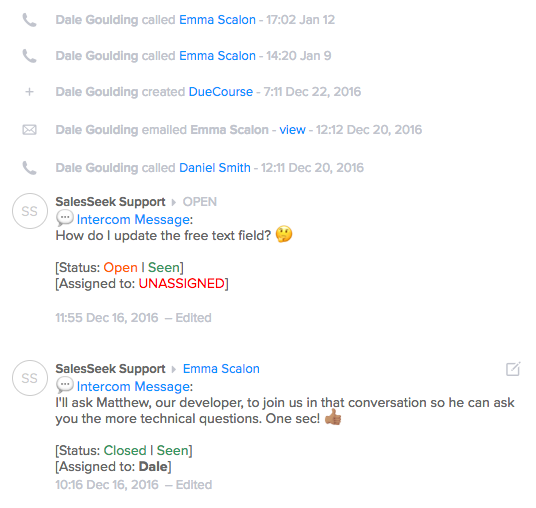Knowing whether the use of emojis in a Sales context can be difficult. We recently introduced emojis to the functionality of SalesSeek and we now have the whole team using them.
This improvement was initially met with some resistance. One member of the team can be quoted as describing them as “ugly”, but given some time to use them and he is now the biggest advocate for emojis within our application.
I know I have asked myself the question before: ‘should I include an emoji in this email I’m sending?’ On one hand, it conveys context of emotion; exactly why emojis have been created. On the other, what if the recipient doesn’t approve? Could the single use of a smiley damage a professional relationship? Personally, I think not.
Intercom have long been advocates
for using emojis.
“Emoji, stickers and much more will spread through all aspects of our digital lives as they support complex human communication needs that have evolved over thousands of years.”
This use of emoticon in a more modern form of communication (instant messenger) is largely accepted and appreciated. Most of us have been in situations where no matter how many times you rewrite a response, it can’t help but sound sarcastic in your head. Introduce an emoji and voilà, problem solved.
We love using Intercom and our integration to SalesSeek allows us to add to the context of the relationship. If I can see that they have been responding with emojis in their communication, then it’s probably worth me continuing the trend in email.

General use of emojis isn’t so well received.
An interesting thought is despite emojis seeing a rise in popularity with companies such as Apple redesigning and improving their own emojis, why are they still being met with some resistance in the workplace?
A recent study by Statistica showed that across the board, we all felt as though companies are “trying too hard” when they use emoji’s in their ads and communication.

In my opinion, this graph doesn’t take into account the stage of the Business using the emojis in their communication. There is somewhat of an unwritten perception here whereby older ‘corporate/enterprise’ organizations are being perceived as trying to win you over with their use of “hip” styles of communication. Has anyone ever questioned Facebook trying to introduce emojis into their interface, yes initially, but now it’s a feature that pretty much all members use regularly.
If these new exciting companies are leading the way with their adoption of emojis in their business language, surely this is clearing a path for all young companies to be taking advantage of a more receptive style of communication. Particularly those trying to target millennials who use of stickers and emoticons particularly resonates with.
Are emoji’s the right
communication tool for me?
Your use of emojis in email communication should only really be done so if it accurately reflects your style of communication in person. If you send a winky face to come across as cheeky in an email, but you pick up the phone and Mr. Corporate comes out, then this is going to give off a serious impression of holding dual personalities. If you put this in the context of a business scenario, perhaps providing a service, who wants to deal with inconsistency? Not me, that’s for sure!
Stick to what you know, if you regularly communicate in emojis then continue that into the workplace, it’s clichéd but; people buy from people. All you are doing is letting your personality shine.
As a bonus here are our most used emojis and some suggested ‘never to use in an email’ emojis:
| Safe | Not Safe |
|---|---|
| ? | ? |
| ? | ? |
| ? | ? |
| ? | ? |
| ? | ❤️ |
| ? | ? |
| ? | ? |
